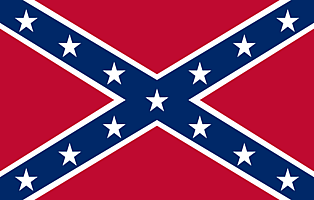
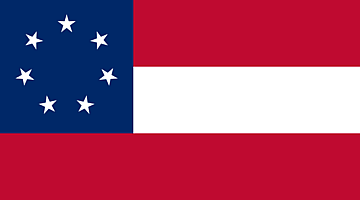
Seven-Star Version, May 4-May 21, 1861
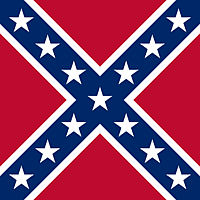
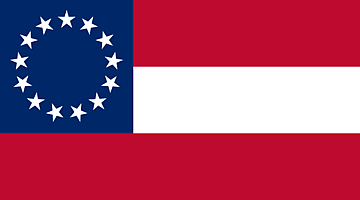
Thirteen-Star Version, November 1861 to May 1863

(The "Stainless Banner")
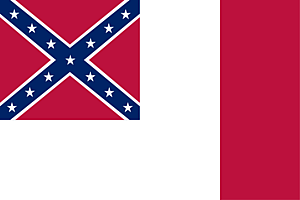
Note: In order to see the large images in this page across the full display of your web browser, click here to see the page shown in a separate window.
 The Second
Confederate Navy Jack
|
 The First
National Flag of the Confederacy (The "Stars and Bars")
Seven-Star Version, May 4-May 21, 1861 |

The Confederate Battle Flag
|
 The First National
Flag of the Confederacy
Thirteen-Star Version, November 1861 to May 1863 |

The Second National Flag of the Confederacy
(The "Stainless Banner") May 1863-March 1865
|
 The Third National
Flag of the Confederacy
March 1865 to defeat
|
The flag Lincoln could see on the Marshall House Hotel in May, 1861, was not the flag most people in the 21st century think of as "the Confederate Flag." In fact, though some flags had designs similar to that flag, it was never the Confederacy's national flag. However, though, under the name The Second Confederate Navy Jack, (top row, left) it was used by the Confederate Navy, at least on some occasions.
The first National Flag, (top and middle row, right), went through several versions, adding a star every time a new state joined the Confederacy.This is the flag that is most properly known as the "Stars and Bars." Some felt this flag was too similar to the Union flag. (Why does one one of the versions shown have 13 stars, when normally, only 11 states are counted as being in the Confederacy? This was because groups in Missouri and Kentucky declared that those states had seceded and joined the new country. The Southern government recognized those claims, even if the Confederates never controlled those two states -- both of which were also "claimed" by the Union.)
What we think of as the Confederate Flag is a variation of the square Battle Flag, (above, second row, left) which also served as the basis for the regimental flags of many Confederate army units.The second National Flag simply put this design in the corner of a white field. Many complained that this combined a battle flag with a white flag of truce or surrender -- and if the wind failed to show the whole flag, it might well be mistaken for a surrender flag on the field of battle. The red bar was added in the Third National Flag in 1865 -- but by then, the Confederacy had only weeks to live, and that version of the flag saw little use. Variations of the Battle Flag design have come to symbolize the Confederacy. The Second Navy Jack and the very similar Army of Tennessee Battle Flag, both of which "stretched" the design to a rectangle, are, for all intents and purposes, identical to the "Dixie" flag of today -- but neither was ever considered the "national" flag.
Note: the history of Confederate flags is a long and involved story. See the Flags of the Confederacy website for much more information. Note: the flag images used above are from the Wikipedia Commons image bank. See also the Wikipedia article on Confederate Flags.
(scoll down for images and text)
The two images below are by David Gilmour Blythe, and demonstrate a combination of politics, paint, and allegory more often seen in political cartoons.| David Gilmour Blythe 1862 Museum of Fine Arts, Boston Click here to link to MFA's page on this image Lincoln is using his railsplitter's maul to beat back the dragon of rebellion, but he is chained to a stumped label DEMOCRACY, with the Constitution sitting on top of it, with a book (perhaps the bible? and a bottle (of rum ?) over top of the the Constitution. The whole affair is braced up against a cracked Liberty Bell. It should be noted that the Democratic Party was referred to as "the Democracy" and this is clearly Blythe's intent here. The bible and bottle of rum can be interpreted as a symbol of Rum and Romanism -- a swipe at Catholics who were reputed to drink more rum, whiskey, and other hard liquor than Protestants supposedly drank. The Irish harp by the dragon's hoof -- and the stereotypical Irish figure pulling at the chain -- give a further clue to what Blythe is saying: Democrats, Catholics, and Irish immigrants are in an unholy alliance to keep Lincoln from prosecuting the war vigorously. Meanwhile,.a couple of disreputable types lounge in the entrance of Tamony Hall (an obvious pun with money and Tammany Hall -- the corrupt poltical machine that ran New York). The "O" in "Tamony" takes the form of a demon of some sort, just in case the message wasn't clear enough. Grafiitti scrawled on the Hall warns the rebellion can only be crushed by constitutional means. It is signed by Fernando Wood & co, (Wood was the pro-seccessiononist mayor of New York, who even toyed with seceding the city itself out of the Union). The notation "need we Saymour" is a pun on the name of Horatio Seymour, the Governor of New York, who opposed many of Lincoln's measures, such as the draft, limits on personal liberty, and the Emancipation Proclamation. Meanhwhile, there is quite literally a "fire in the rear" that no one is attempting to put out, and a gallows, ready, perhaps, for hanging traitors, is standing unused. In other words, Wood, Seymour, and other politicians are willing to stand idly by and let the country fail, even if they aren't actively supporting the rebellion. |
| President Lincoln, writing the Proclamation of Freedom, January 1, 1863 Clcsee text below image -- Click on image to see it full-size 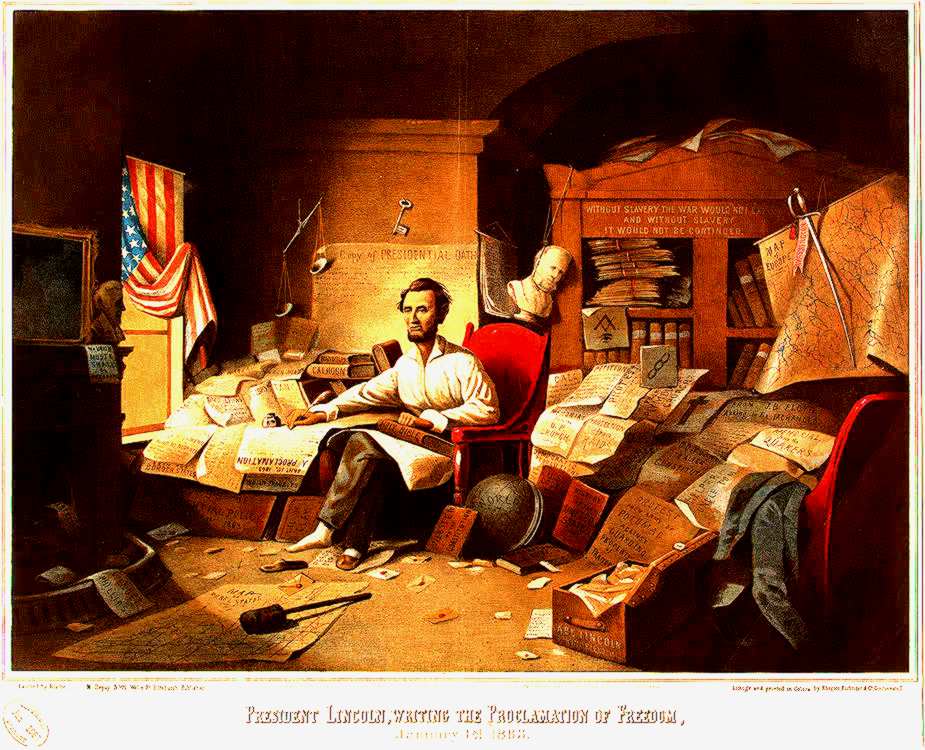 |
|
This print, directly based on another Blythe painting, is, if anything, even more full of allegory and symbolic images. Lincoln pauses to contemplate his work in the midst of writing the Emancipation Proclamation (ie, the "the Proclamation of Freedom"). It would appear that he has been sitting up working all night: he is in his slippers, his jacket is discarded in a corner, and the light of a new dawn streams in through a window curtained by the Union flag. The scales of justice, badly out of balance, hang on the wall behind him, as does a large key, perhaps waiting to opens the locks and unchain the slaves. Directly below the key a copy of the Presidential Oath is posted on the wall. The calm, clear-eyed president sits, pen in one hand, the other resting on the Holy Bible, which sits in his lap on top of a copy of the U.S. Constitution. Lincoln's railsplitting maul rests on a map of the rebel states, and his foot sits on a paper marked "PEACE DEMOCRACY" (a reference to anti-war Democrats). A bust of Andrew Jackson sits on the mantle, holding down a bit of paper with his words, "The Union must and shall be preserved." A bust of Lincoln's immediate predecessor, James Buchanan, who allowed the Southern states to secede, hangs by a cord wrapped around its neck. A motto on the shelf behind reads "WITHOUT SLAVERY THE WAR WOULD NOT EXIST AND WITHOUT SLAVERY IT WOULD NOT BE CONTINUED." Protests, petitions and letters against slavery are strewn on and around the couch, along with masonic symbols and a Christian cross. A map of Europe (whose countries were flirting with the idea of recognising the Confederarcy) is on the wall, with Washington's sword hanging over it . Reports of battles, diplomatic problems, and the writings of pro-slavery thinkers are piled up between Lincoln and the window. Note: we have increased the brightness and contrast of this image to make the background details more legible. Click here to see it without increased contrast. If you want to see this picture in super high-resolution, click on this link. The file on that link is about 2 million bytes. Put your mouse key over the image and click or right-click (depending on your browser) to view it full-sized. |